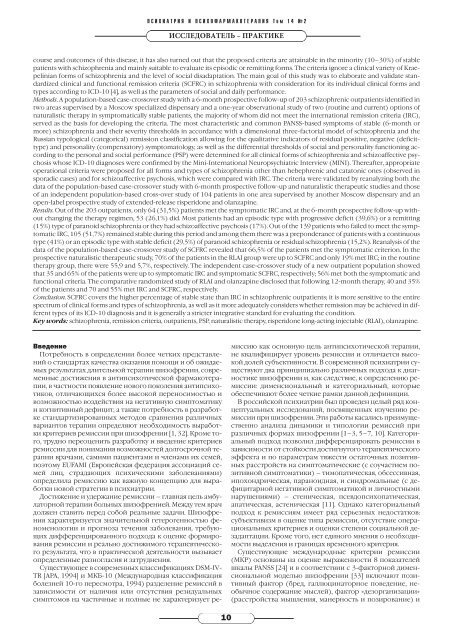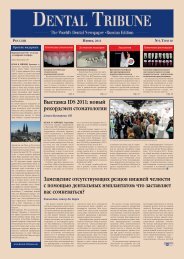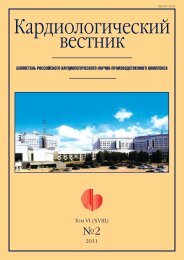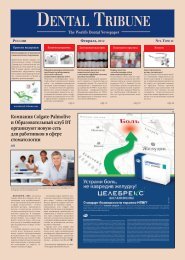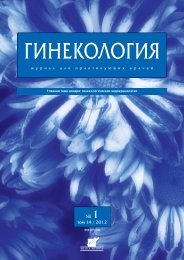PDF 8 MB - Consilium Medicum
PDF 8 MB - Consilium Medicum
PDF 8 MB - Consilium Medicum
You also want an ePaper? Increase the reach of your titles
YUMPU automatically turns print PDFs into web optimized ePapers that Google loves.
Введение<br />
Потребность в определении более четких представлений<br />
о стандартах качества оказания помощи и об ожидаемых<br />
результатах длительной терапии шизофрении, современные<br />
достижения в антипсихотической фармакотерапии,<br />
в частности появление нового поколения антипсихотиков,<br />
отличающихся более высокой переносимостью и<br />
возможностью воздействия на негативную симптоматику<br />
и когнитивный дефицит, а также потребность в разработке<br />
стандартизированных методов сравнения различных<br />
вариантов терапии определяют необходимость выработки<br />
критериев ремиссии при шизофрении [1, 32]. Кроме того,<br />
трудно переоценить разработку и введение критериев<br />
ремиссии для понимания возможностей долгосрочной терапии<br />
врачами, самими пациентами и членами их семей,<br />
поэтому EUFAMI (Европейская федерация ассоциаций семей<br />
лиц, страдающих психическими заболеваниями)<br />
определила ремиссию как важную концепцию для выработки<br />
новой стратегии в психиатрии.<br />
Достижение и удержание ремиссии – главная цель амбулаторной<br />
терапии больных шизофренией. Между тем врач<br />
должен ставить перед собой реальные задачи. Шизофрения<br />
характеризуется значительной гетерогенностью феноменологии<br />
и прогноза течения заболевания, требующих<br />
дифференцированного подхода к оценке формирования<br />
ремиссии и реально достижимого терапевтического<br />
результата, что в практической деятельности вызывает<br />
определенные разногласия и затруднения.<br />
Существующее в современных классификациях DSM-IV-<br />
TR [APA, 1994] и МКБ-10 (Международная классификация<br />
болезней 10-го пересмотра, 1994) разделение ремиссий в<br />
зависимости от наличия или отсутствия резидуальных<br />
симптомов на частичные и полные не характеризует ре-<br />
П С И Х И А Т Р И Я И П С И Х О Ф А Р М А К О Т Е Р А П И Я Т о м 1 4 № 2<br />
ИССЛЕДОВАТЕЛЬ – ПРАКТИКЕ<br />
course and outcomes of this disease, it has also turned out that the proposed criteria are attainable in the minority (10–30%) of stable<br />
patients with schizophrenia and mainly suitable to evaluate its episodic or remitting forms. The criteria ignore a clinical variety of Kraepelinian<br />
forms of schizophrenia and the level of social disadaptation. The main goal of this study was to elaborate and validate standardized<br />
clinical and functional remission criteria (SCFRC) in schizophrenia with consideration for its individual clinical forms and<br />
types according to ICD-10 [4], as well as the parameters of social and daily performance.<br />
Methods. A population-based case-crossover study with a 6-month prospective follow-up of 203 schizophrenic outpatients identified in<br />
two areas supervised by a Moscow specialized dispensary and a one-year observational study of two (routine and current) options of<br />
naturalistic therapy in symptomatically stable patients, the majority of whom did not meet the international remission criteria (IRC),<br />
served as the basis for developing the criteria. The most characteristic and common PANSS-based symptoms of stable (6-month or<br />
more) schizophrenia and their severity thresholds in accordance with a dimensional three-factorial model of schizophrenia and the<br />
Russian typological (categorical) remission classification allowing for the qualitative indicators of residual positive, negative (deficittype)<br />
and personality (compensatory) symptomatology, as well as the differential thresholds of social and personality functioning according<br />
to the personal and social performance (PSP) were determined for all clinical forms of schizophrenia and schizoaffective psychosis<br />
whose ICD-10 diagnoses were confirmed by the Mini-International Neuropsychiatric Interview (MINI). Thereafter, appropriate<br />
operational criteria were proposed for all forms and types of schizophrenia other than hebephrenic and catatonic ones (observed in<br />
sporadic cases) and for schizoaffective psychosis, which were compared with IRC. The criteria were validated by reanalyzing both the<br />
data of the population-based case-crossover study with 6-month prospective follow-up and naturalistic therapeutic studies and those<br />
of an independent population-based cross-over study of 104 patients in one area supervised by another Moscow dispensary and an<br />
open-label prospective study of extended-release risperidone and olanzapine.<br />
Results. Out of the 203 outpatients, only 64 (31,5%) patients met the symptomatic IRC and, at the 6-month prospective follow-up without<br />
changing the therapy regimen, 53 (26,1%) did. Most patients had an episodic type with progressive deficit (39,6%) or a remitting<br />
(15%) type of paranoid schizophrenia or they had schizoaffective psychosis (17%). Out of the 139 patients who failed to meet the symptomatic<br />
IRC, 105 (51,7%) remained stable during this period and among them there was a preponderance of patients with a continuous<br />
type (41%) or an episodic type with stable deficit (29,5%) of paranoid schizophrenia or residual schizophrenia (15,2%). Reanalysis of the<br />
data of the population-based case-crossover study of SCFRC revealed that 66,5% of the patients met the symptomatic criterion. In the<br />
prospective naturalistic therapeutic study, 70% of the patients in the RLAI group were up to SCFRC and only 19% met IRC; in the routine<br />
therapy group, there were 55,9 and 5,7%, respectively. The independent case-crossover study of a new outpatient population showed<br />
that 35 and 65% of the patients were up to symptomatic IRC and symptomatic SCFRC, respectively; 56% met both the symptomatic and<br />
functional criteria. The comparative randomized study of RLAI and olanzapine disclosed that following 12-month therapy, 40 and 35%<br />
of the patients and 70 and 55% met IRC and SCFRC, respectively.<br />
Conclusion. SCFRC covers the higher percentage of stable state than IRC in schizophrenic outpatients; it is more sensitive to the entire<br />
spectrum of clinical forms and types of schizophrenia, as well as it more adequately considers whether remission may be achieved in different<br />
types of its ICD-10 diagnosis and it is generally a stricter integrative standard for evaluating the condition.<br />
Key words: schizophrenia, remission criteria, outpatients, PSP, naturalistic therapy, risperidone long-acting injectable (RLAI), olanzapine.<br />
10<br />
миссию как основную цель антипсихотической терапии,<br />
не квалифицирует уровень ремиссии и отличается высокой<br />
долей субъективности. В современной психиатрии существуют<br />
два принципиально различных подхода к диагностике<br />
шизофрении и, как следствие, к определению ремиссии:<br />
дименсиональный и категориальный, которые<br />
обеспечивают более четкие рамки данной дефиниции.<br />
В российской психиатрии был проведен целый ряд концептуальных<br />
исследований, посвященных изучению ремиссии<br />
при шизофрении. Эти работы касались преимущественно<br />
анализа динамики и типологии ремиссий при<br />
различных формах шизофрении [1–3, 5–7, 10]. Категориальный<br />
подход позволил дифференцировать ремиссии в<br />
зависимости от стойкости достигнутого терапевтического<br />
эффекта и по параметрам тяжести остаточных позитивных<br />
расстройств на симптоматические (с соучастием позитивной<br />
симптоматики) – тимопатическая, обсессивная,<br />
ипохондрическая, параноидная, и синдромальные (с дефицитарной<br />
негативной симптоматикой и личностными<br />
нарушениями) – стеническая, псевдопсихопатическая,<br />
апатическая, астеническая [11]. Однако категориальный<br />
подход к ремиссиям имеет ряд серьезных недостатков:<br />
субъективизм в оценке типа ремиссии, отсутствие операциональных<br />
критериев и оценки степени социальной дезадаптации.<br />
Кроме того, нет единого мнения о необходимости<br />
выделения и границах временного критерия.<br />
Существующие международные критерии ремиссии<br />
(МКР) основаны на оценке выраженности 8 показателей<br />
шкалы PANSS [24] и в соответствии с 3-факторной дименсиональной<br />
моделью шизофрении [33] включают позитивный<br />
фактор (бред, галлюцинаторное поведение, необычное<br />
содержание мыслей), фактор «дезорганизации»<br />
(расстройства мышления, манерность и позирование) и


